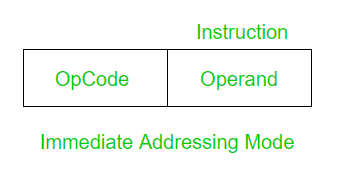How Does Register Addressing Differ From Direct Addressing?
Divergence between Directly and Immediate Addressing Modes
Prerequisite – Addressing Modes
1. Direct Addressing Style:
In straight addressing way, the address field contains the address of the operand.
Constructive Accost (EA) = address field of operand

Example: Add the contents of register 1001 to the accumulator.
Add (1001)
Only a single retention reference is required to access data. So no additional calculations are required to work out effective address.
2. Immediate Addressing Mode:
In immediate addressing way, the operand is a part of the instruction.
Hither the Operand = Accost Field

Example: Add five to the accumulator.
Add together 5
No memory reference is required to fetch data. Then no boosted calculations are required to work out the effective address. It is a fast method. But the downside is that information technology has a limited range.
Now let's compare Direct and Immediate addressing modes.
| Directly Addressing Style | Immediate Addressing Mode |
|---|---|
| Address fields contains the effective accost of operand | There is no address field as the operand is a office of the instruction. |
| It requires one reference to memory. | It does not crave any reference to retentivity. |
| Information technology is slower compared to immediate mode. | Information technology is a faster procedure. |
| It has more range than in immediate mode. | Information technology has a limited range. |
| Case: Add (1001) | Example: Add 5 |
How Does Register Addressing Differ From Direct Addressing?,
Source: https://www.geeksforgeeks.org/difference-between-direct-and-immediate-addressing-modes/
Posted by: doyleficepleturem.blogspot.com


0 Response to "How Does Register Addressing Differ From Direct Addressing?"
Post a Comment